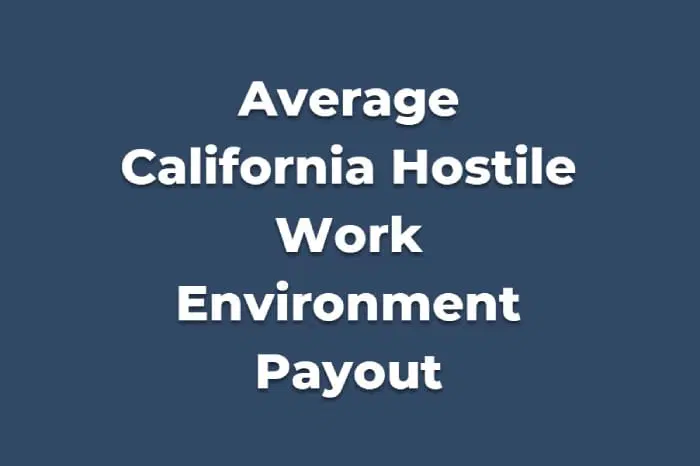
Average California Hostile Work Environment Payout (2024 Update)
Legally reviewed by: Jessica Anvar Stotz, JD, MBA
Short answer: According to Expertise.com, most hostile work environment settlements are roughly $50,000. Settlements can also be six and seven figures in more severe cases. Learn what your case could be worth below.
Average California Hostile Work Environment Payout
| Complexity of Case | Settlement Amount |
| Minor | Approximately: $10,000 – $50,000 |
| Moderate | Approximately: $50,000 – $250,000 |
| High | Approximately: $250,000 – $1,000,000+ |
Estimate What Your Potential Case Might Be Worth
Use our hostile work environment settlement calculator below to estimate what your potential case might be worth. Get an estimated settlement amount in as quick as 90 seconds.
Example Hostile Work Environment Settlements
- Tesla must pay $137 million to ex-worker over hostile work environment, racism
- ‘Criminal Minds’ producers settle harassment case for $3 million
- Riot Games agrees to pay $100 million in settlement of class-action gender discrimination lawsuit
Factors that Can Influence Settlement Amounts
- Severity of the Behavior: The seriousness and frequency of the hostile behavior experienced by the victim can impact the settlement. Severe or pervasive misconduct typically results in higher settlements.
- Documentation and Evidence: The availability and strength of evidence, such as emails, witness statements, or documentation of incidents, play a crucial role in proving the existence of a hostile work environment and can influence the settlement amount.
- Company Policies and Procedures: Whether the employer had proper policies and procedures in place to prevent and address harassment can affect the settlement. If the employer failed to take appropriate action despite knowing about the hostile behavior, it could lead to a higher settlement.
- Financial Resources of the Employer: The financial resources of the employer may influence their willingness to settle. Larger companies with more resources may be more inclined to settle for a higher amount to avoid negative publicity or potential legal costs.
- Legal Representation: The quality and experience of legal representation for both parties can impact the negotiation process and the final settlement amount.
- Emotional and Psychological Impact: The emotional and psychological impact of the hostile work environment on the victim is often considered in settlement negotiations. Compensation may be awarded for emotional distress and suffering caused by the harassment.
- Precedent and Case Law: Previous settlements and case law in similar situations can influence the negotiations and the final settlement amount.
- Public Relations Considerations: Employers may consider the potential damage to their reputation and brand image when deciding whether to settle and for how much.
- Duration and Cost of Litigation: The time and cost associated with litigating the case through trial can influence settlement negotiations. Both parties may be motivated to settle to avoid the expenses and uncertainties of a trial.
- Non-Monetary Remedies: In addition to monetary compensation, non-monetary remedies such as changes in company policies, training programs, or disciplinary actions against the harasser may be included in the settlement agreement.
*These factors interact in complex ways and can vary from case to case, ultimately shaping the terms and outcome of a settlement related to a hostile work environment.
Types of Compensation a Victim Could Receive
In a settlement related to a hostile work environment, several types of compensation can be awarded to the victim. These may include:
- Monetary Damages: This compensation typically covers financial losses incurred as a result of the hostile work environment, such as lost wages, back pay, or future earnings if the victim was forced to resign or was terminated because of the harassment.
- Compensation for Emotional Distress: Victims of a hostile work environment may experience emotional distress, anxiety, depression, or other psychological harm. Monetary compensation may be awarded to address these emotional damages.
- Punitive Damages: In cases where the employer’s conduct is particularly egregious or intentional, punitive damages may be awarded to punish the employer and deter similar behavior in the future. These damages go beyond compensating the victim and are intended to send a message to the employer.
- Attorney’s Fees and Legal Costs: In some settlements, the employer may agree to cover the victim’s attorney’s fees and legal costs incurred during the litigation process. This provision helps ensure that the victim does not bear the financial burden of seeking justice.
- Non-Monetary Remedies: In addition to monetary compensation, the settlement may include non-monetary remedies aimed at preventing future harassment and creating a safer work environment. These remedies may include mandatory training programs, policy changes, or disciplinary actions against the harasser.
- Reinstatement or Promotion: If the victim was wrongfully terminated or denied opportunities for advancement due to the hostile work environment, the settlement may include provisions for reinstatement to their former position or promotion to a higher position.
- Confidentiality Agreement: As part of the settlement, the parties may agree to a confidentiality clause, prohibiting them from discussing the details of the settlement publicly. This is often done to protect the privacy of the parties involved and prevent reputational harm to the employer.
- Retaliation Protection: The settlement may include provisions to protect the victim from retaliation by the employer or coworkers for reporting the harassment or participating in the legal process.
*These types of compensation can vary depending on the specifics of each case, the severity of the harassment, and the negotiated terms of the settlement agreement.
How to Prove a Hostile Work Environment
To prove a hostile work environment claim in California, an employee typically needs to establish the following elements:
- Discriminatory Conduct: The employee must demonstrate that they were subjected to conduct or behavior based on their protected characteristics, such as race, color, religion, sex, national origin, age, disability, or other protected categories under California law.
- Severity and Pervasiveness: The conduct or behavior must be sufficiently severe or pervasive to create an abusive working environment. This means that the harassment must be more than just occasional, isolated incidents or mere offensive utterances. The behavior should be severe enough to create an intimidating, hostile, or offensive work environment.
- Objectively and Subjectively Offensive: The conduct or behavior must be both objectively and subjectively offensive. Objectively, a reasonable person in the employee’s position would find the conduct hostile or abusive. Subjectively, the employee must have perceived the conduct as hostile or abusive.
- Employer Responsibility: The employer knew or should have known about the hostile work environment and failed to take reasonable steps to prevent or promptly correct the situation. This can be established by showing that the employee reported the harassment to a supervisor or manager, or that the conduct was so pervasive that the employer should have been aware of it.
Evidence to Prove a Hostile Work Environment
To prove a hostile work environment claim, employees may need to provide evidence such as:
- Detailed documentation of the offensive conduct, including dates, times, locations, and witnesses.
- Emails, text messages, or other written communications that demonstrate the hostile behavior.
- Witness testimony from coworkers or others who observed or experienced the hostile conduct.
- Evidence of reporting the harassment to the employer and the employer’s response (or lack thereof).
- Records of any disciplinary actions or terminations related to the harassment.
- Expert testimony or reports from psychologists, therapists, or other professionals regarding the emotional or psychological impact of the hostile work environment.
It’s important to note that the threshold for establishing a hostile work environment claim in California is high, and the conduct must be more than just occasional teasing or offensive comments. The employee must demonstrate a pattern of severe and pervasive harassment that altered the conditions of their employment and created an abusive working environment.
When You May or May Not Have a Claim
When You May Have a Claim
You may have a valid hostile work environment claim in California if:
- Discrimination: The offensive conduct or behavior is based on your protected characteristics, such as race, color, religion, sex, national origin, age, disability, or other protected categories under California law.
- Severe and Pervasive: The conduct or behavior is severe and pervasive, meaning it is more than just occasional or isolated incidents. The harassment is frequent and creates an intimidating, hostile, or offensive work environment.
- Objectively and Subjectively Offensive: A reasonable person in your position would find the conduct or behavior offensive, and you perceive it as hostile or abusive.
- Interference with Work: The hostile conduct or behavior significantly interferes with your ability to perform your job duties or creates an abusive working environment.
- Employer Knowledge: You reported the harassment to your employer, or the conduct was so pervasive that your employer should have been aware of it.
- Lack of Action: Your employer failed to take reasonable steps to prevent or promptly correct the hostile work environment after being made aware of it.
When You May Not Have a Claim
You may not have a valid hostile work environment claim in California if:
- Isolated Incidents: The offensive conduct or behavior is limited to isolated or occasional incidents, rather than being severe and pervasive.
- Not Based on Protected Characteristics: The conduct or behavior is not related to your protected characteristics, such as race, color, religion, sex, national origin, age, or disability.
- Subjective Perception: While you perceive the conduct as offensive, a reasonable person in your position would not find it hostile or abusive.
- No Impact on Work: The conduct or behavior does not significantly interfere with your ability to perform your job duties or create an intimidating or offensive work environment.
- Employer Action: Your employer took reasonable steps to address and correct the situation after being made aware of the alleged harassment.
- No Knowledge: You did not report the harassment to your employer, and the conduct was not pervasive enough for your employer to have known about it.
*It’s important to note that determining whether you have a valid hostile work environment claim is highly fact-specific and can be complex. If you believe you may have a claim, it’s advisable to consult with an experienced employment law attorney who can evaluate the specific details of your situation and provide guidance on the best course of action.
Benefits of Hiring an Attorney
Hiring a lawyer for a hostile work environment claim can provide numerous benefits. A skilled attorney can help you navigate the complex legal process, ensure you meet all deadlines and filing requirements, and build a strong case with compelling evidence.
They can advise you on the best legal strategies, represent you in negotiations or court proceedings, and protect your rights throughout the process.
Additionally, having legal representation can increase the chances of obtaining a favorable settlement or outcome, as employers often take claims more seriously when an attorney is involved.
Ultimately, a lawyer can provide invaluable guidance and advocacy, increasing the likelihood of achieving justice and compensation for the hostile work environment you experienced.
Connect with a Lawyer
Looking to see if you have a valid hostile work environment case? Contact LawLinq to connect with some of the best employment attorneys in the state. All initial consultations are free.


